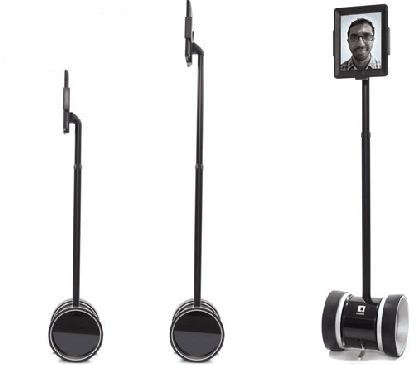The term and concept of telepresence is attributed to Marvin Minsky, pioneer of artificial intelligence [217]; see also [269,292,315]. In the most idealized case, which we are far from achieving with current technology, it could completely eliminate the need to physically travel. It could also revolutionize the lives of people who have limited mobility due to disabilities or advanced age. In terms of technical challenges, telepresence involves the integration of two components: teleoperation and VR.
Figure 13.9:
The Double telepresence robot is a screen and camera on a stick. The robot costs around $2500, and the screen is a tablet, such as an iPad. The height can even be adjusted remotely so that the person may appear to be sitting or standing. (Picture by Double Robotics.)
 |
Figure 13.9 shows a telepresence system that is commercially available and serves as a useful point of reference. Similar robots have appeared in telepresence research [138,174,247,324]. The robot is controlled by the user through a tablet or smartphone, while at the remote site the robot carries a tablet that provides a wide-angle camera and a screen to show the user's face. The base is designed to roll through typical office spaces, and the tablet height is adjustable to allow face-to-face interaction. The vehicle is top-heavy, which results in a control problem called the inverted pendulum to stabilize the tablet.
Several aspects come to mind regarding a telepresence robot:
- Sensory input: What will it sense from the remote physical world? For visual input, it could contain cameras that directly map the eye viewpoints and are even matched to user head motions (as was shown in Figure 1.12(a)). Alternatively, it could capture and transmit an entire panorama. Going even further, this could be extended to depth and light fields. Auditory input is captured using one or more microphones, depending on the importance of localization. Some other possible inputs for telepresence are temperature, contact forces, humidity, odors, and the robot's remaining battery life.
- Mobility: Where can the robot go? With no mobility, telepresence is reduced to a stationary camera and microphone. If the task is to interact with people, then it should be able to move into the same places that people are capable of entering. In other settings, many modes of mobility may be desirable, such as flying, swimming, or even crawling through pipes.
- Audiovisual output: At one extreme, the telepresence system could seem like a ``fly on the wall'' and not disrupt life at the remote site. More commonly, it is designed to interact with people, which could be accomplished by a screen and a speaker. If the robot has some anthropomorphic characteristics, then it may also be able to make gestures that communicate emotion or intent with other people.
- Manipulation: The telepresence system shown in Figure 13.9 targets face-to-face interaction, and therefore neglects being able to manipulate objects at the remote site. A telepresence robot is much more powerful if it can grasp, manipulate, carry, and ungrasp objects. It could then open doors, operate elevators, go grocery shopping, and so on.
The remainder of this section covers ongoing challenges in the development of better telepresence systems.
Steven M LaValle
2020-11-11

